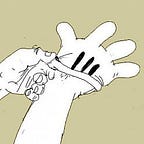#FreeMickey 2028
Of mouse and man, character and brand
Mickey Mouse celebrates 90th birthday this year it means by the 18 November 2028 Mickey will be 100 years old and it is time to release him from his bonds.
What bonds? Well, Disney’s constant concern that the copyrights for Mickey will be lost and he will become PUBLIC DOMAIN (free for public use) has resulted in a prolonged extension of copyright laws to the character. A process that affects all the products of culture and free work in general, even if we are not aware of it in our everyday life.
For me Mickey Mouse is not just a commercial icon. When I call “free Mickey” I speak on a different level. Mickey, as a trade symbol, should belong to and identify with the company that created it. But Mickey is not a brand figure, he has become one over the years. I do not know if he was the first brand figure but he is certainly the leading figure, the most valuable, the most recognized and beloved in the world.
Mickey, more than anything represents a particular society, it represents a global idea: that we can empathize with a cartoon character. Mickey is a human being, a painting in which life has been blown into. A Golem. In itself, there is nothing in it. He’s almost nobody: Mickey’s design is one of the minimalist designs that exist in popular culture, almost like a Smiley icon: three connected circles that make people smile. Even those who try to point out Mickey’s character will find it difficult to do so because Mickey is basically just a good guy. He has no outstanding feature. If you try to imagine how Mickey will react to a particular situation, you will probably imagine him reacting in a rather boring yet positive way. He is not particularly brave, nor smart or especially funny, not naughty or nervous or energetic … he is mediocre. But, a bit like Kermit the frog , he has a leadership side. His simplicity places him forward when it comes to the existence of animated characters. I know some of you raise an eyebrow and I do not mean to be apologetic when I say Mickey Mouse is an animated hero who can break the fourth wall in the deep sense of the word. to be real.
what is real
Mickey Mouse is an animated character who acts as an actor. He takes off and dresses in various costumes, roles and periods. Like Bugs Bunny, he is a character who manages to sink into a perfect shape from one world to another according to his play role. There are not many such characters who manage to maintain their identity as a cartoon character and as an actor at the same time. For this reason Mickey is also able to get out of the screen physically. He did it in “Fantasia” when he shook the conductor’s hand (in 1940!) And did so in “GET A HORSE” with three-dimensional glasses. But “with great power comes responsibility”. When Mickey is aware of being an actor, he also becomes the person who leads the world depicted by creatures that are not “an illusion of life” but have a real independent personality. You can easily compare this to Blade Runner when we see characters created by a person but have gained independence, a consistent and coherent personality over the years.
So yes, there is something poetic about wanting to free Mickey from the bonds of the corporation that controls him, but there is also truth in that. When we refer to a character portrayed as an entity with freedom, we awaken something about our own human desire for freedom. Not necessarily from corporations but from being the character they wrote to us, to play the game.
This is a humanistic reading that also has implications for the practice of the legal attitude toward cultural products. Creation has always evolved by imitation, copying, and upgrading. Our attitude to “originality” is a fantasy far from reality. Each cultural floor is built on my back and sometimes on the ruins of the previous floors. This is a natural development. The mechanism of copyright, with all its positive aspects intended to provide a space for the earning of artists from their works, becomes a paralyzing mechanism, both on the psychological level and on the practical level. It is impossible, over time, to constrain a natural creative process to take into account the rights of previous creators even if they have long since died. One of the implications of this is the development of a wide range of graphic visual variantions, at the expense of the depth development of new narrative structures that are often created by playing with existing materials.
So what do I suggest?
If you are still here, the idea is to launch a campaign under the #Free_Mickey strategy in which we will raise awareness of the consequences of copyright laws’ expansion. Mickey is an icon, a positive icon of humanity, creativity and content for the whole family, but it is also an icon of one of the strongest corporations in the world that are spreading over many brands from Marvell to FOX.
As in “Who Framed Roger Rabbit”, which ends with the toons taking control of TOON TOWN, and their own lives, here comes the call to free Mickey. His 90th birthday is a good time to call for the release of this character to his independent life. Disney has another 10 years to “squeeze the lemon” and then allow Mickey to return to the public and to the collective culture without borders, hoping he is only the first swallow.
If there is a public interest, this may indeed happen.
Are you with me? Click:
https://www.eff.org/about/staff/cory-doctorow https://www.eff.org/deeplinks/2016/01/well-probably-never-free-mickey-thats-beside-point
